Hofstede's Cultural Dimensions: Impact on Qantas Airlines Strategy
VerifiedAdded on 2023/06/13
|7
|2184
|295
Essay
AI Summary
This essay provides an overview of Hofstede’s cultural dimensions and analyzes its impact on Qantas Airlines. It explains Hofstede’s cultural dimensions, originated by Professor Geert Hofstede, as a framework for cross-cultural communication and its influence on workplace values. The analysis covers the six dimensions: power distance, individualism vs. collectivism, masculinity vs. femininity, uncertainty avoidance, long-term orientation vs. short-term normative orientation, and indulgence vs. restraint, relating each to Australia's cultural profile. The essay discusses how Qantas uses this framework to understand different cultures, promote diversity, manage expatriates, and attract customers from various ethnic backgrounds. It also addresses potential disadvantages, such as cultural misunderstandings and the importance of respecting all cultures. Furthermore, the essay connects cultural analysis to job satisfaction, explaining how understanding employees' cultural backgrounds can improve their satisfaction and reduce culture shock. The essay concludes that cultural analysis is crucial for organizations operating internationally, helping them to adapt to diverse environments and satisfy their employees.
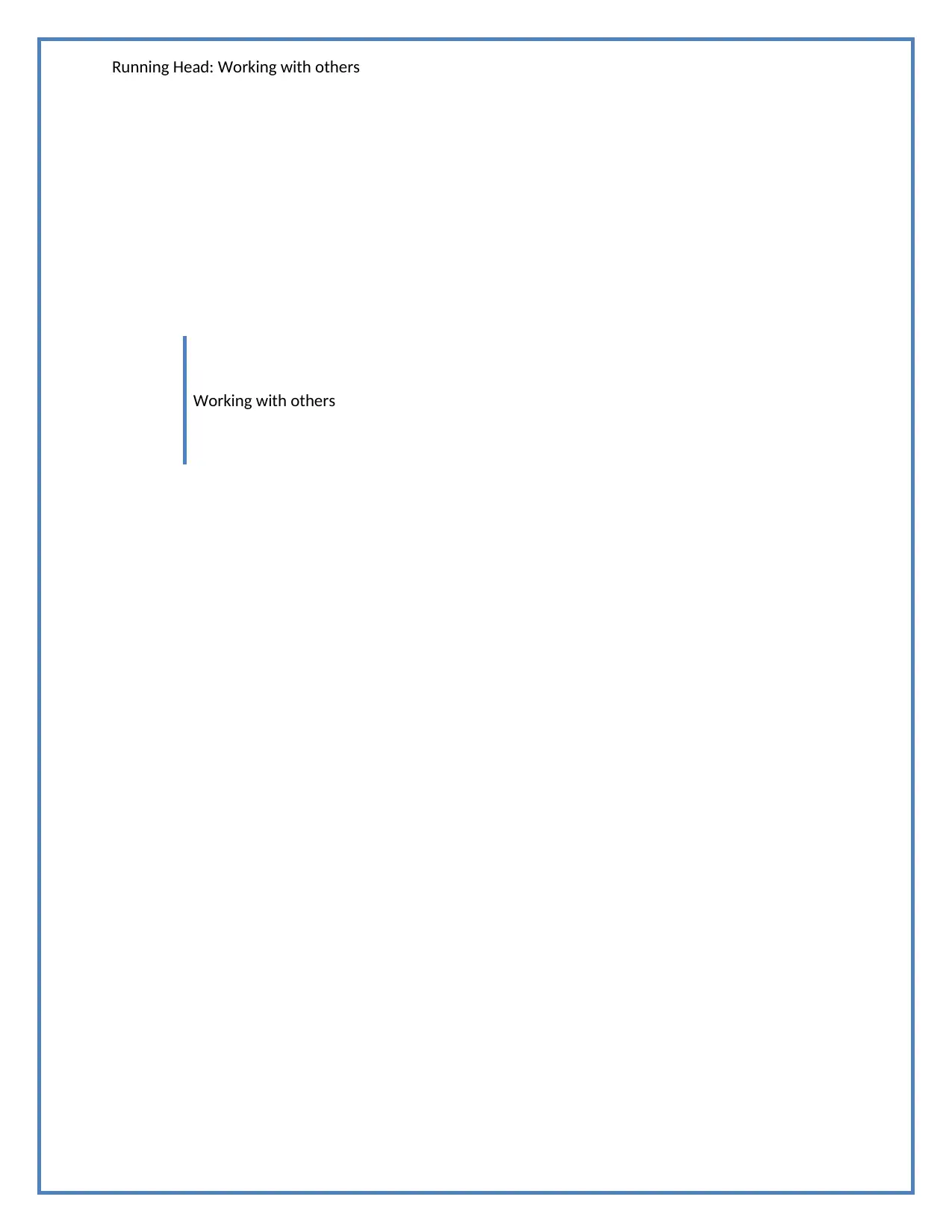
Running Head: Working with others
Working with others
Working with others
Paraphrase This Document
Need a fresh take? Get an instant paraphrase of this document with our AI Paraphraser
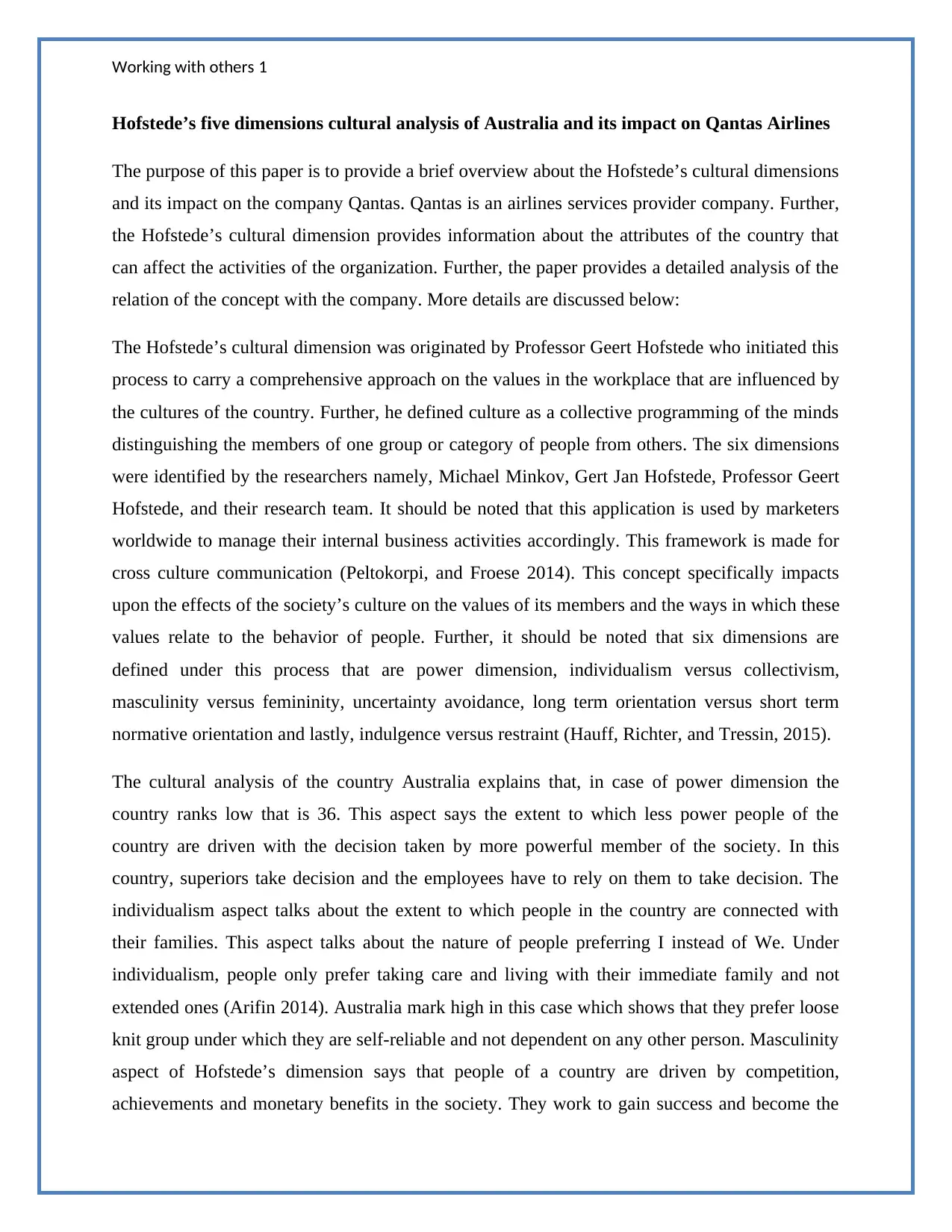
Working with others 1
Hofstede’s five dimensions cultural analysis of Australia and its impact on Qantas Airlines
The purpose of this paper is to provide a brief overview about the Hofstede’s cultural dimensions
and its impact on the company Qantas. Qantas is an airlines services provider company. Further,
the Hofstede’s cultural dimension provides information about the attributes of the country that
can affect the activities of the organization. Further, the paper provides a detailed analysis of the
relation of the concept with the company. More details are discussed below:
The Hofstede’s cultural dimension was originated by Professor Geert Hofstede who initiated this
process to carry a comprehensive approach on the values in the workplace that are influenced by
the cultures of the country. Further, he defined culture as a collective programming of the minds
distinguishing the members of one group or category of people from others. The six dimensions
were identified by the researchers namely, Michael Minkov, Gert Jan Hofstede, Professor Geert
Hofstede, and their research team. It should be noted that this application is used by marketers
worldwide to manage their internal business activities accordingly. This framework is made for
cross culture communication (Peltokorpi, and Froese 2014). This concept specifically impacts
upon the effects of the society’s culture on the values of its members and the ways in which these
values relate to the behavior of people. Further, it should be noted that six dimensions are
defined under this process that are power dimension, individualism versus collectivism,
masculinity versus femininity, uncertainty avoidance, long term orientation versus short term
normative orientation and lastly, indulgence versus restraint (Hauff, Richter, and Tressin, 2015).
The cultural analysis of the country Australia explains that, in case of power dimension the
country ranks low that is 36. This aspect says the extent to which less power people of the
country are driven with the decision taken by more powerful member of the society. In this
country, superiors take decision and the employees have to rely on them to take decision. The
individualism aspect talks about the extent to which people in the country are connected with
their families. This aspect talks about the nature of people preferring I instead of We. Under
individualism, people only prefer taking care and living with their immediate family and not
extended ones (Arifin 2014). Australia mark high in this case which shows that they prefer loose
knit group under which they are self-reliable and not dependent on any other person. Masculinity
aspect of Hofstede’s dimension says that people of a country are driven by competition,
achievements and monetary benefits in the society. They work to gain success and become the
Hofstede’s five dimensions cultural analysis of Australia and its impact on Qantas Airlines
The purpose of this paper is to provide a brief overview about the Hofstede’s cultural dimensions
and its impact on the company Qantas. Qantas is an airlines services provider company. Further,
the Hofstede’s cultural dimension provides information about the attributes of the country that
can affect the activities of the organization. Further, the paper provides a detailed analysis of the
relation of the concept with the company. More details are discussed below:
The Hofstede’s cultural dimension was originated by Professor Geert Hofstede who initiated this
process to carry a comprehensive approach on the values in the workplace that are influenced by
the cultures of the country. Further, he defined culture as a collective programming of the minds
distinguishing the members of one group or category of people from others. The six dimensions
were identified by the researchers namely, Michael Minkov, Gert Jan Hofstede, Professor Geert
Hofstede, and their research team. It should be noted that this application is used by marketers
worldwide to manage their internal business activities accordingly. This framework is made for
cross culture communication (Peltokorpi, and Froese 2014). This concept specifically impacts
upon the effects of the society’s culture on the values of its members and the ways in which these
values relate to the behavior of people. Further, it should be noted that six dimensions are
defined under this process that are power dimension, individualism versus collectivism,
masculinity versus femininity, uncertainty avoidance, long term orientation versus short term
normative orientation and lastly, indulgence versus restraint (Hauff, Richter, and Tressin, 2015).
The cultural analysis of the country Australia explains that, in case of power dimension the
country ranks low that is 36. This aspect says the extent to which less power people of the
country are driven with the decision taken by more powerful member of the society. In this
country, superiors take decision and the employees have to rely on them to take decision. The
individualism aspect talks about the extent to which people in the country are connected with
their families. This aspect talks about the nature of people preferring I instead of We. Under
individualism, people only prefer taking care and living with their immediate family and not
extended ones (Arifin 2014). Australia mark high in this case which shows that they prefer loose
knit group under which they are self-reliable and not dependent on any other person. Masculinity
aspect of Hofstede’s dimension says that people of a country are driven by competition,
achievements and monetary benefits in the society. They work to gain success and become the
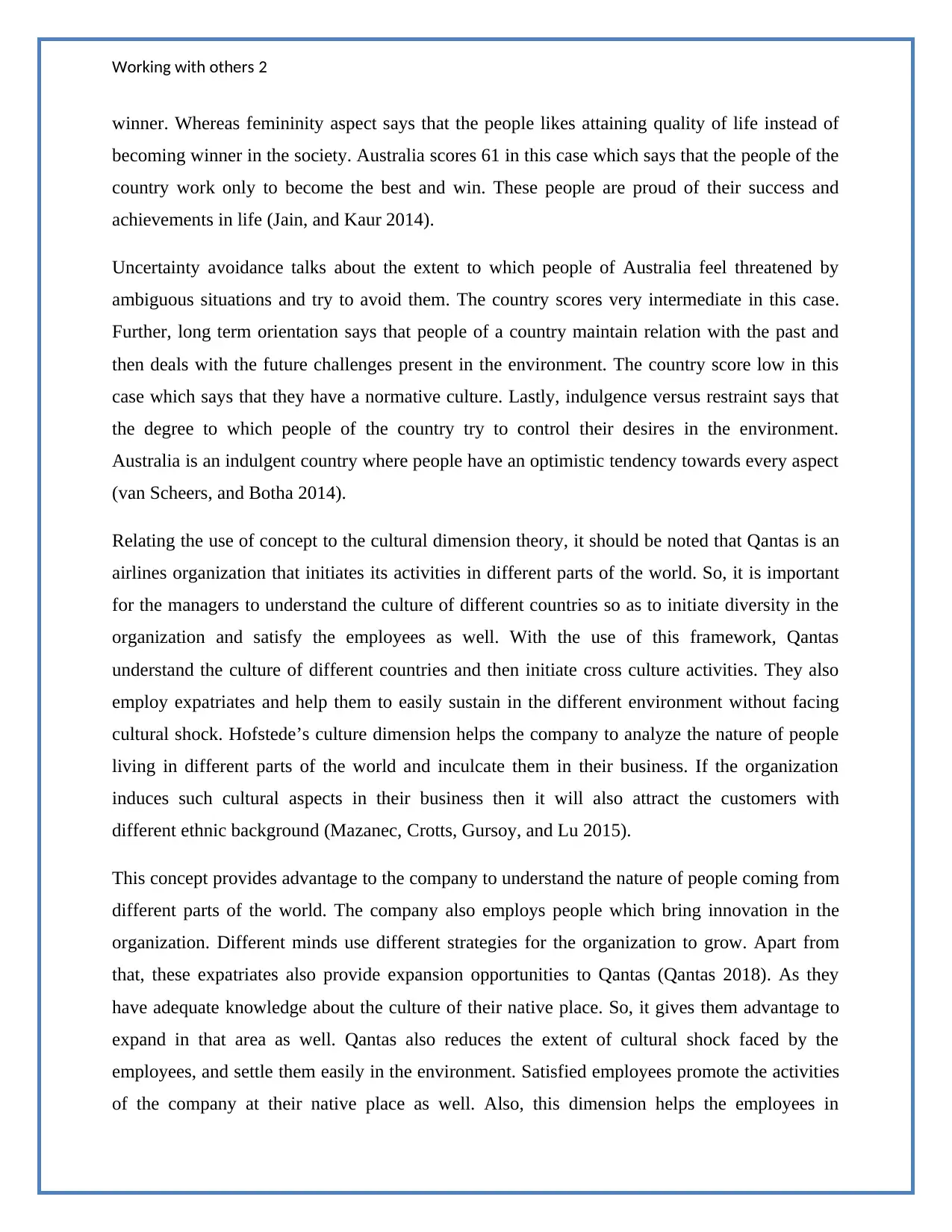
Working with others 2
winner. Whereas femininity aspect says that the people likes attaining quality of life instead of
becoming winner in the society. Australia scores 61 in this case which says that the people of the
country work only to become the best and win. These people are proud of their success and
achievements in life (Jain, and Kaur 2014).
Uncertainty avoidance talks about the extent to which people of Australia feel threatened by
ambiguous situations and try to avoid them. The country scores very intermediate in this case.
Further, long term orientation says that people of a country maintain relation with the past and
then deals with the future challenges present in the environment. The country score low in this
case which says that they have a normative culture. Lastly, indulgence versus restraint says that
the degree to which people of the country try to control their desires in the environment.
Australia is an indulgent country where people have an optimistic tendency towards every aspect
(van Scheers, and Botha 2014).
Relating the use of concept to the cultural dimension theory, it should be noted that Qantas is an
airlines organization that initiates its activities in different parts of the world. So, it is important
for the managers to understand the culture of different countries so as to initiate diversity in the
organization and satisfy the employees as well. With the use of this framework, Qantas
understand the culture of different countries and then initiate cross culture activities. They also
employ expatriates and help them to easily sustain in the different environment without facing
cultural shock. Hofstede’s culture dimension helps the company to analyze the nature of people
living in different parts of the world and inculcate them in their business. If the organization
induces such cultural aspects in their business then it will also attract the customers with
different ethnic background (Mazanec, Crotts, Gursoy, and Lu 2015).
This concept provides advantage to the company to understand the nature of people coming from
different parts of the world. The company also employs people which bring innovation in the
organization. Different minds use different strategies for the organization to grow. Apart from
that, these expatriates also provide expansion opportunities to Qantas (Qantas 2018). As they
have adequate knowledge about the culture of their native place. So, it gives them advantage to
expand in that area as well. Qantas also reduces the extent of cultural shock faced by the
employees, and settle them easily in the environment. Satisfied employees promote the activities
of the company at their native place as well. Also, this dimension helps the employees in
winner. Whereas femininity aspect says that the people likes attaining quality of life instead of
becoming winner in the society. Australia scores 61 in this case which says that the people of the
country work only to become the best and win. These people are proud of their success and
achievements in life (Jain, and Kaur 2014).
Uncertainty avoidance talks about the extent to which people of Australia feel threatened by
ambiguous situations and try to avoid them. The country scores very intermediate in this case.
Further, long term orientation says that people of a country maintain relation with the past and
then deals with the future challenges present in the environment. The country score low in this
case which says that they have a normative culture. Lastly, indulgence versus restraint says that
the degree to which people of the country try to control their desires in the environment.
Australia is an indulgent country where people have an optimistic tendency towards every aspect
(van Scheers, and Botha 2014).
Relating the use of concept to the cultural dimension theory, it should be noted that Qantas is an
airlines organization that initiates its activities in different parts of the world. So, it is important
for the managers to understand the culture of different countries so as to initiate diversity in the
organization and satisfy the employees as well. With the use of this framework, Qantas
understand the culture of different countries and then initiate cross culture activities. They also
employ expatriates and help them to easily sustain in the different environment without facing
cultural shock. Hofstede’s culture dimension helps the company to analyze the nature of people
living in different parts of the world and inculcate them in their business. If the organization
induces such cultural aspects in their business then it will also attract the customers with
different ethnic background (Mazanec, Crotts, Gursoy, and Lu 2015).
This concept provides advantage to the company to understand the nature of people coming from
different parts of the world. The company also employs people which bring innovation in the
organization. Different minds use different strategies for the organization to grow. Apart from
that, these expatriates also provide expansion opportunities to Qantas (Qantas 2018). As they
have adequate knowledge about the culture of their native place. So, it gives them advantage to
expand in that area as well. Qantas also reduces the extent of cultural shock faced by the
employees, and settle them easily in the environment. Satisfied employees promote the activities
of the company at their native place as well. Also, this dimension helps the employees in
⊘ This is a preview!⊘
Do you want full access?
Subscribe today to unlock all pages.

Trusted by 1+ million students worldwide
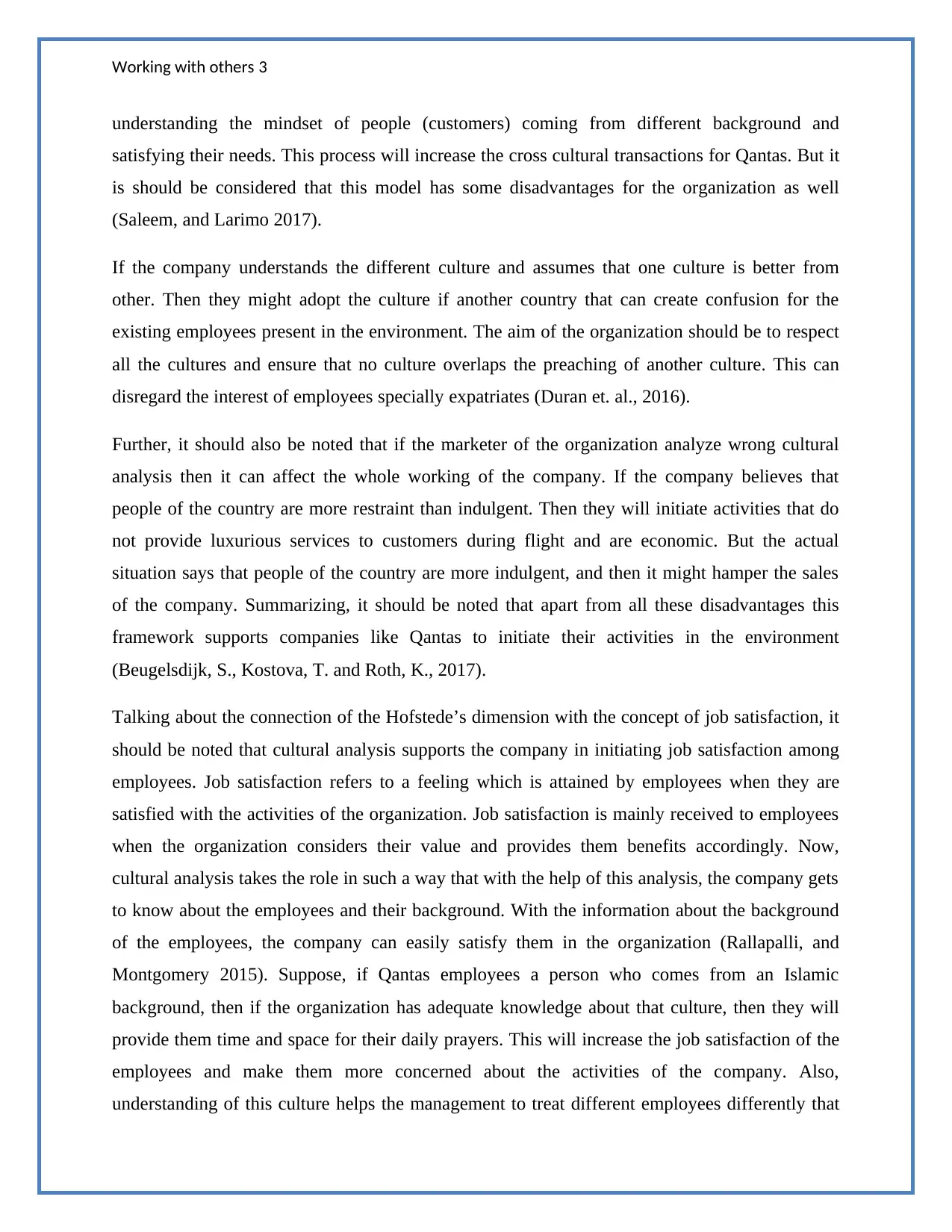
Working with others 3
understanding the mindset of people (customers) coming from different background and
satisfying their needs. This process will increase the cross cultural transactions for Qantas. But it
is should be considered that this model has some disadvantages for the organization as well
(Saleem, and Larimo 2017).
If the company understands the different culture and assumes that one culture is better from
other. Then they might adopt the culture if another country that can create confusion for the
existing employees present in the environment. The aim of the organization should be to respect
all the cultures and ensure that no culture overlaps the preaching of another culture. This can
disregard the interest of employees specially expatriates (Duran et. al., 2016).
Further, it should also be noted that if the marketer of the organization analyze wrong cultural
analysis then it can affect the whole working of the company. If the company believes that
people of the country are more restraint than indulgent. Then they will initiate activities that do
not provide luxurious services to customers during flight and are economic. But the actual
situation says that people of the country are more indulgent, and then it might hamper the sales
of the company. Summarizing, it should be noted that apart from all these disadvantages this
framework supports companies like Qantas to initiate their activities in the environment
(Beugelsdijk, S., Kostova, T. and Roth, K., 2017).
Talking about the connection of the Hofstede’s dimension with the concept of job satisfaction, it
should be noted that cultural analysis supports the company in initiating job satisfaction among
employees. Job satisfaction refers to a feeling which is attained by employees when they are
satisfied with the activities of the organization. Job satisfaction is mainly received to employees
when the organization considers their value and provides them benefits accordingly. Now,
cultural analysis takes the role in such a way that with the help of this analysis, the company gets
to know about the employees and their background. With the information about the background
of the employees, the company can easily satisfy them in the organization (Rallapalli, and
Montgomery 2015). Suppose, if Qantas employees a person who comes from an Islamic
background, then if the organization has adequate knowledge about that culture, then they will
provide them time and space for their daily prayers. This will increase the job satisfaction of the
employees and make them more concerned about the activities of the company. Also,
understanding of this culture helps the management to treat different employees differently that
understanding the mindset of people (customers) coming from different background and
satisfying their needs. This process will increase the cross cultural transactions for Qantas. But it
is should be considered that this model has some disadvantages for the organization as well
(Saleem, and Larimo 2017).
If the company understands the different culture and assumes that one culture is better from
other. Then they might adopt the culture if another country that can create confusion for the
existing employees present in the environment. The aim of the organization should be to respect
all the cultures and ensure that no culture overlaps the preaching of another culture. This can
disregard the interest of employees specially expatriates (Duran et. al., 2016).
Further, it should also be noted that if the marketer of the organization analyze wrong cultural
analysis then it can affect the whole working of the company. If the company believes that
people of the country are more restraint than indulgent. Then they will initiate activities that do
not provide luxurious services to customers during flight and are economic. But the actual
situation says that people of the country are more indulgent, and then it might hamper the sales
of the company. Summarizing, it should be noted that apart from all these disadvantages this
framework supports companies like Qantas to initiate their activities in the environment
(Beugelsdijk, S., Kostova, T. and Roth, K., 2017).
Talking about the connection of the Hofstede’s dimension with the concept of job satisfaction, it
should be noted that cultural analysis supports the company in initiating job satisfaction among
employees. Job satisfaction refers to a feeling which is attained by employees when they are
satisfied with the activities of the organization. Job satisfaction is mainly received to employees
when the organization considers their value and provides them benefits accordingly. Now,
cultural analysis takes the role in such a way that with the help of this analysis, the company gets
to know about the employees and their background. With the information about the background
of the employees, the company can easily satisfy them in the organization (Rallapalli, and
Montgomery 2015). Suppose, if Qantas employees a person who comes from an Islamic
background, then if the organization has adequate knowledge about that culture, then they will
provide them time and space for their daily prayers. This will increase the job satisfaction of the
employees and make them more concerned about the activities of the company. Also,
understanding of this culture helps the management to treat different employees differently that
Paraphrase This Document
Need a fresh take? Get an instant paraphrase of this document with our AI Paraphraser
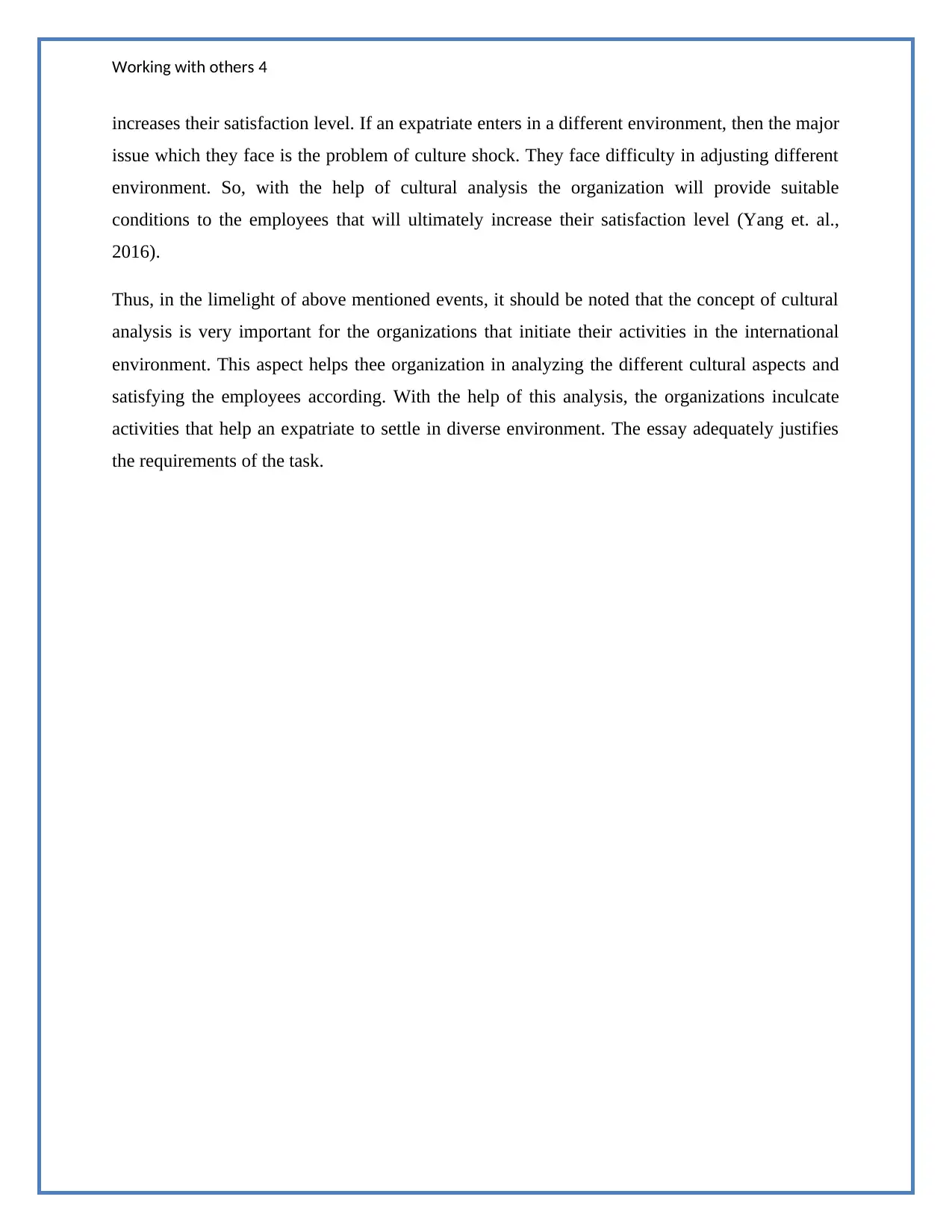
Working with others 4
increases their satisfaction level. If an expatriate enters in a different environment, then the major
issue which they face is the problem of culture shock. They face difficulty in adjusting different
environment. So, with the help of cultural analysis the organization will provide suitable
conditions to the employees that will ultimately increase their satisfaction level (Yang et. al.,
2016).
Thus, in the limelight of above mentioned events, it should be noted that the concept of cultural
analysis is very important for the organizations that initiate their activities in the international
environment. This aspect helps thee organization in analyzing the different cultural aspects and
satisfying the employees according. With the help of this analysis, the organizations inculcate
activities that help an expatriate to settle in diverse environment. The essay adequately justifies
the requirements of the task.
increases their satisfaction level. If an expatriate enters in a different environment, then the major
issue which they face is the problem of culture shock. They face difficulty in adjusting different
environment. So, with the help of cultural analysis the organization will provide suitable
conditions to the employees that will ultimately increase their satisfaction level (Yang et. al.,
2016).
Thus, in the limelight of above mentioned events, it should be noted that the concept of cultural
analysis is very important for the organizations that initiate their activities in the international
environment. This aspect helps thee organization in analyzing the different cultural aspects and
satisfying the employees according. With the help of this analysis, the organizations inculcate
activities that help an expatriate to settle in diverse environment. The essay adequately justifies
the requirements of the task.
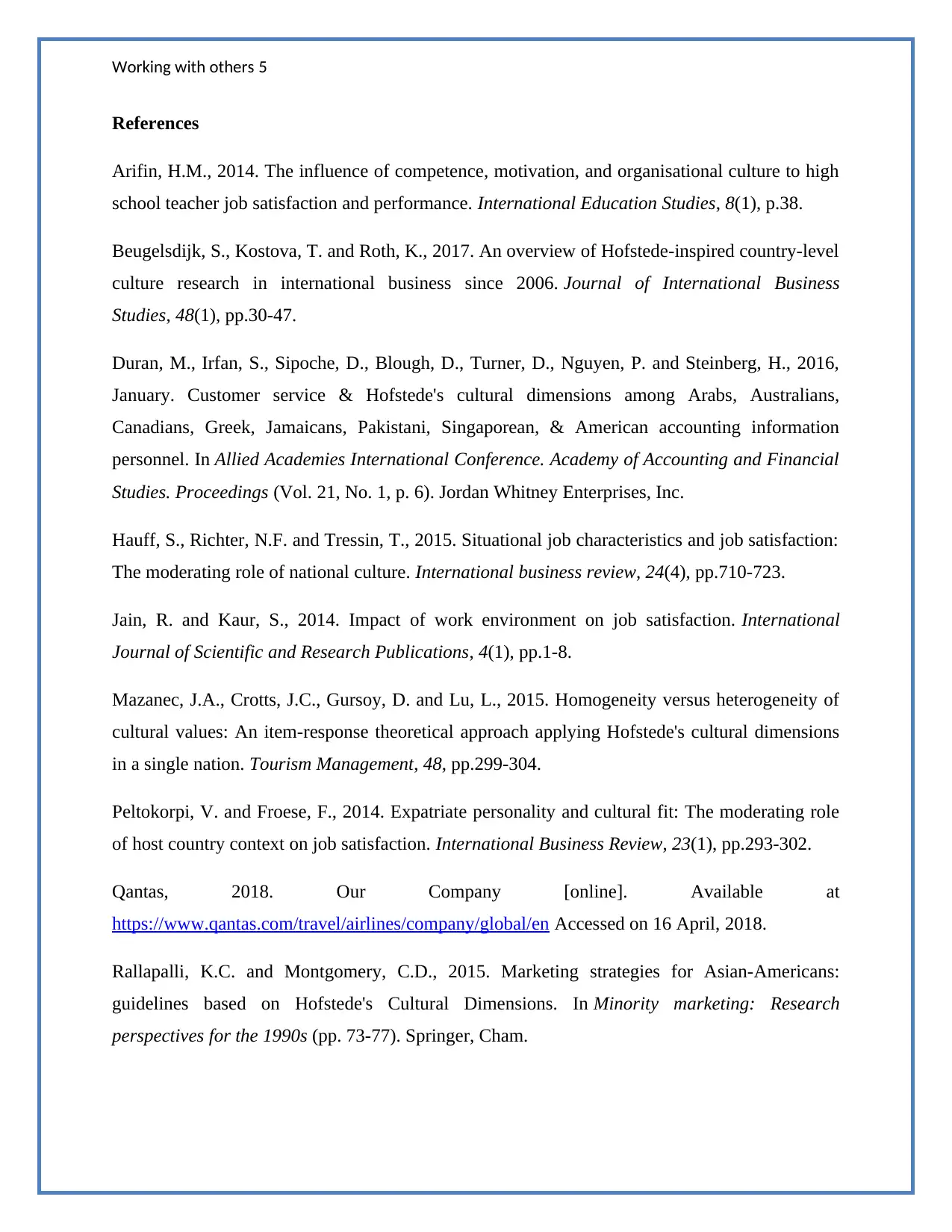
Working with others 5
References
Arifin, H.M., 2014. The influence of competence, motivation, and organisational culture to high
school teacher job satisfaction and performance. International Education Studies, 8(1), p.38.
Beugelsdijk, S., Kostova, T. and Roth, K., 2017. An overview of Hofstede-inspired country-level
culture research in international business since 2006. Journal of International Business
Studies, 48(1), pp.30-47.
Duran, M., Irfan, S., Sipoche, D., Blough, D., Turner, D., Nguyen, P. and Steinberg, H., 2016,
January. Customer service & Hofstede's cultural dimensions among Arabs, Australians,
Canadians, Greek, Jamaicans, Pakistani, Singaporean, & American accounting information
personnel. In Allied Academies International Conference. Academy of Accounting and Financial
Studies. Proceedings (Vol. 21, No. 1, p. 6). Jordan Whitney Enterprises, Inc.
Hauff, S., Richter, N.F. and Tressin, T., 2015. Situational job characteristics and job satisfaction:
The moderating role of national culture. International business review, 24(4), pp.710-723.
Jain, R. and Kaur, S., 2014. Impact of work environment on job satisfaction. International
Journal of Scientific and Research Publications, 4(1), pp.1-8.
Mazanec, J.A., Crotts, J.C., Gursoy, D. and Lu, L., 2015. Homogeneity versus heterogeneity of
cultural values: An item-response theoretical approach applying Hofstede's cultural dimensions
in a single nation. Tourism Management, 48, pp.299-304.
Peltokorpi, V. and Froese, F., 2014. Expatriate personality and cultural fit: The moderating role
of host country context on job satisfaction. International Business Review, 23(1), pp.293-302.
Qantas, 2018. Our Company [online]. Available at
https://www.qantas.com/travel/airlines/company/global/en Accessed on 16 April, 2018.
Rallapalli, K.C. and Montgomery, C.D., 2015. Marketing strategies for Asian-Americans:
guidelines based on Hofstede's Cultural Dimensions. In Minority marketing: Research
perspectives for the 1990s (pp. 73-77). Springer, Cham.
References
Arifin, H.M., 2014. The influence of competence, motivation, and organisational culture to high
school teacher job satisfaction and performance. International Education Studies, 8(1), p.38.
Beugelsdijk, S., Kostova, T. and Roth, K., 2017. An overview of Hofstede-inspired country-level
culture research in international business since 2006. Journal of International Business
Studies, 48(1), pp.30-47.
Duran, M., Irfan, S., Sipoche, D., Blough, D., Turner, D., Nguyen, P. and Steinberg, H., 2016,
January. Customer service & Hofstede's cultural dimensions among Arabs, Australians,
Canadians, Greek, Jamaicans, Pakistani, Singaporean, & American accounting information
personnel. In Allied Academies International Conference. Academy of Accounting and Financial
Studies. Proceedings (Vol. 21, No. 1, p. 6). Jordan Whitney Enterprises, Inc.
Hauff, S., Richter, N.F. and Tressin, T., 2015. Situational job characteristics and job satisfaction:
The moderating role of national culture. International business review, 24(4), pp.710-723.
Jain, R. and Kaur, S., 2014. Impact of work environment on job satisfaction. International
Journal of Scientific and Research Publications, 4(1), pp.1-8.
Mazanec, J.A., Crotts, J.C., Gursoy, D. and Lu, L., 2015. Homogeneity versus heterogeneity of
cultural values: An item-response theoretical approach applying Hofstede's cultural dimensions
in a single nation. Tourism Management, 48, pp.299-304.
Peltokorpi, V. and Froese, F., 2014. Expatriate personality and cultural fit: The moderating role
of host country context on job satisfaction. International Business Review, 23(1), pp.293-302.
Qantas, 2018. Our Company [online]. Available at
https://www.qantas.com/travel/airlines/company/global/en Accessed on 16 April, 2018.
Rallapalli, K.C. and Montgomery, C.D., 2015. Marketing strategies for Asian-Americans:
guidelines based on Hofstede's Cultural Dimensions. In Minority marketing: Research
perspectives for the 1990s (pp. 73-77). Springer, Cham.
⊘ This is a preview!⊘
Do you want full access?
Subscribe today to unlock all pages.

Trusted by 1+ million students worldwide

Working with others 6
Saleem, S. and Larimo, J., 2017. Hofstede cultural framework and advertising research: An
assessment of the literature. In Advances in Advertising Research (Vol. VII) (pp. 247-263).
Springer Gabler, Wiesbaden.
van Scheers, L. and Botha, J., 2014. Analysing relationship between employee job satisfaction
and motivation. Journal of Business and Retail Management Research, 9(1).
Yang, E., Burger, J., Peters, M., Cruz, B. and Steinberg, H., 2016, January. Customer service
management & Hofstede's cultural dimensions in Australia, Brazil, China, Germany, Japan,
Norway, and the USA. In Allied Academies International Conference. Academy of
Organizational Culture, Communications and Conflict. Proceedings (Vol. 21, No. 1, p. 62).
Jordan Whitney Enterprises, Inc.
Saleem, S. and Larimo, J., 2017. Hofstede cultural framework and advertising research: An
assessment of the literature. In Advances in Advertising Research (Vol. VII) (pp. 247-263).
Springer Gabler, Wiesbaden.
van Scheers, L. and Botha, J., 2014. Analysing relationship between employee job satisfaction
and motivation. Journal of Business and Retail Management Research, 9(1).
Yang, E., Burger, J., Peters, M., Cruz, B. and Steinberg, H., 2016, January. Customer service
management & Hofstede's cultural dimensions in Australia, Brazil, China, Germany, Japan,
Norway, and the USA. In Allied Academies International Conference. Academy of
Organizational Culture, Communications and Conflict. Proceedings (Vol. 21, No. 1, p. 62).
Jordan Whitney Enterprises, Inc.
1 out of 7
Related Documents
Your All-in-One AI-Powered Toolkit for Academic Success.
+13062052269
info@desklib.com
Available 24*7 on WhatsApp / Email
![[object Object]](/_next/static/media/star-bottom.7253800d.svg)
Unlock your academic potential
Copyright © 2020–2026 A2Z Services. All Rights Reserved. Developed and managed by ZUCOL.



